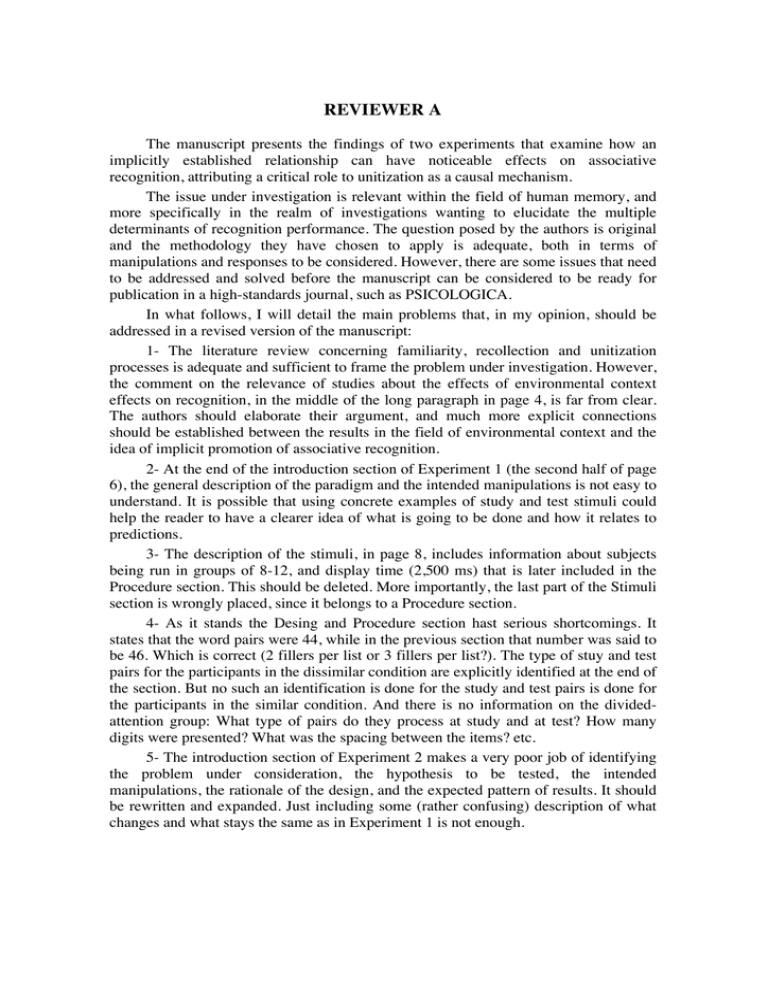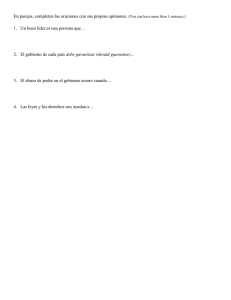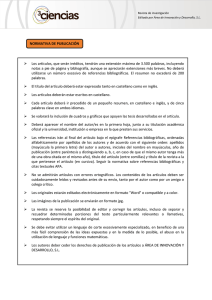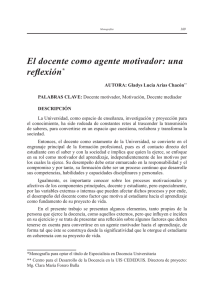REVIEWER A
Anuncio

REVIEWER A The manuscript presents the findings of two experiments that examine how an implicitly established relationship can have noticeable effects on associative recognition, attributing a critical role to unitization as a causal mechanism. The issue under investigation is relevant within the field of human memory, and more specifically in the realm of investigations wanting to elucidate the multiple determinants of recognition performance. The question posed by the authors is original and the methodology they have chosen to apply is adequate, both in terms of manipulations and responses to be considered. However, there are some issues that need to be addressed and solved before the manuscript can be considered to be ready for publication in a high-standards journal, such as PSICOLOGICA. In what follows, I will detail the main problems that, in my opinion, should be addressed in a revised version of the manuscript: 1- The literature review concerning familiarity, recollection and unitization processes is adequate and sufficient to frame the problem under investigation. However, the comment on the relevance of studies about the effects of environmental context effects on recognition, in the middle of the long paragraph in page 4, is far from clear. The authors should elaborate their argument, and much more explicit connections should be established between the results in the field of environmental context and the idea of implicit promotion of associative recognition. 2- At the end of the introduction section of Experiment 1 (the second half of page 6), the general description of the paradigm and the intended manipulations is not easy to understand. It is possible that using concrete examples of study and test stimuli could help the reader to have a clearer idea of what is going to be done and how it relates to predictions. 3- The description of the stimuli, in page 8, includes information about subjects being run in groups of 8-12, and display time (2,500 ms) that is later included in the Procedure section. This should be deleted. More importantly, the last part of the Stimuli section is wrongly placed, since it belongs to a Procedure section. 4- As it stands the Desing and Procedure section hast serious shortcomings. It states that the word pairs were 44, while in the previous section that number was said to be 46. Which is correct (2 fillers per list or 3 fillers per list?). The type of stuy and test pairs for the participants in the dissimilar condition are explicitly identified at the end of the section. But no such an identification is done for the study and test pairs is done for the participants in the similar condition. And there is no information on the dividedattention group: What type of pairs do they process at study and at test? How many digits were presented? What was the spacing between the items? etc. 5- The introduction section of Experiment 2 makes a very poor job of identifying the problem under consideration, the hypothesis to be tested, the intended manipulations, the rationale of the design, and the expected pattern of results. It should be rewritten and expanded. Just including some (rather confusing) description of what changes and what stays the same as in Experiment 1 is not enough. 6- Given the lack of clarity and lack of information noted in the comments above, it is at present difficult to fairly appraise the reported results and conclusions derived by the authors. Although the statistical analyses seem well conducted and the discussion appears to be cohesive, definitive judgment on the author’s interpretation of their results and corresponding implications should wait until some obscure points are clarified and the missing information is provided. In sum, the scientific problem under study is relevant and the attempt to solve it through empirical manipulations at study and at test is original, with interesting effects. But the manuscript should be submitted to a serious revision by the authors before it can be published in PSICOLOGICA: A few minor comments: - There are missing references in the final list: For example Stark et al, 2002; Stark and Squire 2003; Alameda & Cuetos, 1995; Yonelinas, 1999; etc.. The reference list should be revised in a careful way. And the same should be done with the inconsistent way in which authors are cited in the text (for example, missing names in first citations, etc.). - In line 7 of page 6, the final word is “perpetual”; it seems that the word should be “perceptual”. REVIEWER B Sintetizando mucho, la lectura detallada del manuscrito me ha provocado dos sensaciones bien distintas. La primera, la de estar frente a un trabajo experimental bien guiado a nivel teórico, bien diseñado a nivel metodológico, y muy pertinente por el problema de investigación que aborda. La cuestión de si los procesos de familiaridad tienen algún papel en el reconocimiento asociativo, tradicionalmente interpretado en términos de procesos de “recollection”, es muy interesante y apropiada. La segunda impresión, mucho menos positiva, la de enfrentarme a un manuscrito poco claro y difícil de entender en ocasiones. En especial, la introducción, la descripción del material/ procedimiento y alguna parte de la discusión se beneficiarían enormemente de una escritura que hiciera la lectura más fluida y facilitara la comprensión de la lógica detallada del experimento. A continuación paso a ser más específico en las propuestas de mejora. Aunque creo que debe hacerse un esfuerzo en mejorar el manuscrito, los resultados resultan interesantes y contribuyen a nuestra comprensión de los procesos implicados en el reconocimiento asociativo. 1) Una parte del manuscrito que, a mi parecer, requiere una sustancial mejora es el párrafo anterior al Experimento 1. Tal y como está se hace muy complicado entender la lógica de los experimentos que se describen a continuación (especialmente el primero). Cuando se hacen las predicciones, por ejemplo, se hace de forma tan abstracta que resulta difícil pensar en el efecto esperable dadas las condiciones experimentales descritas más adelante. En concreto, la frase “We predict that familiarity differences between intact and rearranged unrelated pairs will increase if the implicit relation established at study is necessarily broken at test in the case of the recombined pairs” debería traducirse en una predicción algo más operacional a fin de hacer claro al lector lo que cabría esperar exactamente dada la hipótesis de los autores. Tampoco la siguiente frase de la introducción “The impact of the effect on hits and false alarms will be a measure of its role in acquisition” ayuda mucho si no se especifica qué patrón específico de aciertos y falsas alarmas, y por qué, esperan los autores. Aunque se hace un intento de plasmar esa predicción en la sección introductoria al Exp. 1 (pág. 6, “If the presence of common letters contributes to unitize both words, there should be a difference in performance between both conditions either in hits, or false alarms or in both due to the increase dissimilarity between intact and rearranged word pairs introducción”, me temo que el resultado sigue siendo ambiguo. Soy consciente de que ser más concreto y clarificador en la introducción del manuscrito exigiría adelantar parcialmente el diseño experimental que subyace a los experimentos, pero dado que en su estado actual la introducción resulta muy confusa, creo que merecerá la pena el esfuerzo. Exactamente la misma lógica se aplica al Experimento 2, sobre el que los autores pasan demasiado superficialmente. 2) Sugiero una revisión de la forma en que se describe el material a fin de facilitar su compresión. Entre otras cosas, creo absolutamente necesario incluir ejemplos de palabras de las distintas condiciones experimentales. En su estado actual resulta difícil entender las especificaciones que se dan en esa sección y ayudarían mucho los ejemplos. Contar con el material íntegro en un apéndice también sería interesante. 3) No veo claramente en qué aspectos de sus resultados se sustentan los autores para decir en la discusión (págs. 17-18) 1) “In our experiments we show that the explicit association was affected by attentional factors whereas the implicit relation was not, although within the context of associative reinstatement”. Me resulta difícil entender la frase en el contexto en el que se enmarca en la discusión y en relación a los resultados encontrados. 4) La hipótesis de la “unitization” con la que interpretan los autores su resultado principal es interesante pero tremendamente circular, pues no hay (al menos no se plantea) forma alguna de estimar su participación independientemente de la ejecución en reconocimiento en base a la familiaridad. Creo que fortalecería la discusión los autores discutieran brevemente esta cuestión y plantearan objeciones y/o soluciones a la misma. 5) Siguiendo a Quamme, Yonelinas y Norman (2007), en la introducción los autores interpretan la “unizitation” como el resultado de procesos estratégicos (“…involvement of familiarity in associative recognition through the use of strategies leading to unization of the presented stimuli”). Dado que los resultados del trabajo se interpretan como apoyo al papel de la familiaridad en el reconocimiento asociativo en base precisamente a procesos de “unizitation”, me gustaría ver en la discusión alguna alusión a esta cuestión. Especialmente teniendo en cuenta el carácter implícito (perceptual) de la similitud entre estímulos considerada en el material experimental. Otros aspectos menores a tener en cuenta: - Tal y como sugiere la APA, sería interesante acompañar las Fs de los efectos más importantes con estimadores de tamaño de esos efectos. - Hay referencias con menos de 6 autores ya abreviadas la primera vez que se citan (e.g., Giovanello et al., 2003; Stark et al., 2002; Turriziani et al., 2004). Deberían estar completas. - Hay omisiones en la lista de referencias (e.g., Stark et al., 2002 y Stark & Squire, 2003). - Soy poco indicado para señalar errores del inglés, pero hay algunos muy evidentes (e.g., uso de “in” en vez de “on” pag. 3 línea 5; “study words written” en vez de “study written words” pag. 6 línea 2; “…shown to not require” en vez de “shown not to require” pág. 16 línea 10). - Cuando en la sección de resultados se describen los análisis de falsas alarmas tras la interacción grupo x condición, se dice “The false alarm rate of the “different set” group was lower…”. Sin embargo, entiendo que se debería decir “Condition” en vez de “Group” porque esa variable no está manipulada entre grupos.





